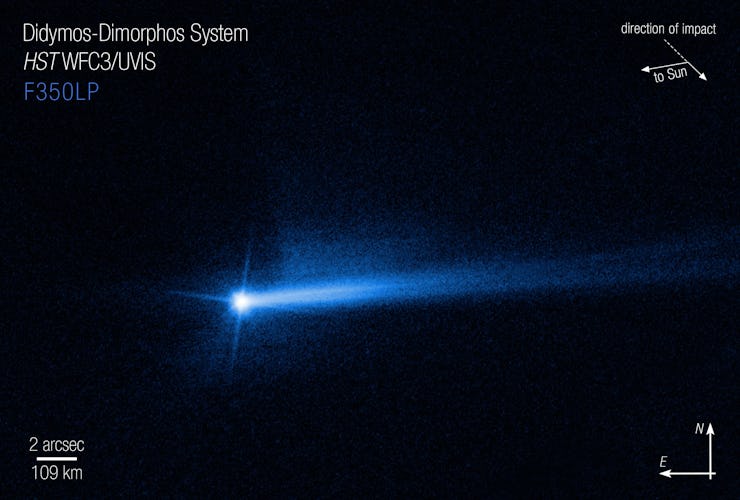Earth's First Asteroid Defense Test Yields Bonus Discoveries for Astronomers
The planetary defense test was a rousing success, but it also offers a glimpse of our Solar System's eventful past.

NASA’s DART mission successfully changed the course of a small asteroid, but it also shed some light on the makeup and evolution of the early Solar System.
When NASA crashed its DART spacecraft into the asteroid Dimorphos (a small asteroid orbiting a larger one called Didymos), the agency proved that it’s possible to knock an incoming asteroid off its course. But astronomers around the world took advantage of the planetary defense test to do some science, too, making DART the latest in a long series of incidents where humans have crashed spacecraft into things just to look at the debris cloud.
In two recent papers, astronomers studied the debris cloud as it evolved for a month after the impact, and also studied how the asteroid’s surface changed after DART smashed into it.
This stop-motion movie from the Hubble Space Telescope shows how Dimorphos’ debris cloud evolved in the days after the DART impact.
Debris Cloud
University of Edinburgh astronomer Cyrielle Opitom and her colleagues used an instrument called MUSE (Multi Unit Spectroscopic Explorer), mounted on the creatively-named Very Large Telescope (an array of four 8.2 meter telescopes in Chile) to measure the light reflecting from the debris cloud that blasted outward from Dimorphos after the crash.
Over the weeks after the impact, Opitum and her colleagues watched the debris cloud coalesce into clumps of dust, curving spirals shaped by the asteroid’s gravity, and a long tail pushed outward by powerful solar winds. The astronomers also watched the reflected light turn gradually redder as the initial cloud of very fine dust particles drifted away, leaving behind the larger ones, which reflect light at longer wavelengths.
There was no trace of water vapor or ice in the debris cloud, which wasn’t surprising. Opitom and her colleagues also looked for traces of DART’s hydrazine propellant, but it too was nowhere to be seen.
“We knew it was a long shot, as the amount of gas that would be left in the tanks from the propulsion system would not be huge,” says Opitom in a recent statement. “Further, some of it would have traveled too far to detect it with MUSE by the time we started observing.” But, in astronomy as in the rest of life, you miss 100 percent of the shots you don’t take.
Opitom and her colleagues published their work in a recent paper in the journal Astronomy and Astrophysics.
The tail stretching out behind Dimorphos is shaped by powerful solar winds, similar to the tail of a comet — but without the gas.
That Left A Mark
The second study, led by Armagh Planetarium and Observatory astronomer Stefano Bagnulo, focused on the asteroid’s surface using an instrument called FORS2 (which stands for Focal Reducer/low dispersion Spectrograph 2, an extremely strained acronym for a pretty cool astronomy instrument. Bagnulo and his colleagues were especially interested in something called polarization — whether the light waves reflected from Dimorphos’s surface were all oriented in the same direction. Different materials and textures can polarize light differently, so studying how that changed after the impact, and as the asteroid’s angle to the sunlight shifts, can reveal something about its makeup and structure.
Bagnulo and his colleagues noticed that after DART crashed into Dimorphos, the asteroid’s surface was suddenly much brighter than it had been before — but the light it reflected was suddenly much less polarized than before.
That could be because, before the impact, VLT was watching the weathered but solid surface of the asteroid; after the impact, it was watching a debris cloud of small particles.
“We know that under certain circumstances, smaller fragments are more efficient at reflecting light and less efficient at polarizing it,” says Armagh Planetarium and Observatory astronomer Zuri Gray, a co-author on the paper. DART’s impact could also have exposed more pristine, less weathered material beneath the asteroid’s weathered surface — and blasted it into space — also accounting for the increase in brightness.
“Maybe the material excavated by the impact was intrinsically brighter and less polarizing than the material on the surface, because it was never exposed to solar wind and solar radiation,” says Bagnulo.
Bagnulo and his colleagues published their related work in a recent paper in Astrophysical Journal Letters.
The DART aftermath, traced in minute detail.
Why It Matters
Astronomers are especially interested in the makeup of asteroids, and the aftermath of collisions between them, because asteroids contain some of the oldest samples of material from the early universe. Collisions are a good way to see that material, courtesy of dusty debris clouds like the one swirling around, and trailing behind, Dimorphos.
“Impacts between asteroids happen naturally, but you never know it in advance. DART is a really great opportunity to study a controlled impact, almost as in a laboratory,” says Opitom. “This research took advantage of a unique opportunity when NASA impacted an asteroid, so it cannot be repeated by any future facility.”
Unless we deliberately crash another spaceship into another asteroid, of course.